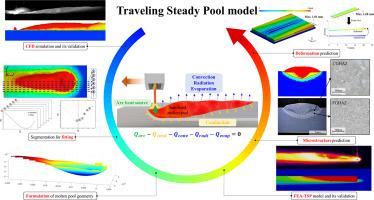A novel heat source model for welding and additive manufacturing: The traveling steady pool approach
IF 6.8
1区 工程技术
Q1 ENGINEERING, MANUFACTURING
引用次数: 0
Abstract
Numerical simulation is essential in solving complex problems in welding and additive manufacturing (AM). However, conventional finite element analysis (FEA) models require repeated parameter tuning due to their inability to capture fluid behavior, while computational fluid dynamics (CFD) is often impractical for industrial applications. To address this, a Traveling Steady Pool (TSP) model was developed based on the observation that the molten pool stabilizes after a critical time. The steady pool geometry was extracted from CFD results, segmented into longitudinal sections, fitted with polynomial functions, and interpolated to construct a three-dimensional profile. This geometry was applied in FEA as a moving Dirichlet boundary at the melting temperature. The TSP model was validated against conventional heat source models and experimental data, including thermal images and bead cross-sections. Thermo-elasto-plastic simulations under various inclination angles further confirmed its predictive capability in deformation analysis. The model also provided physical insights into key phenomena, such as the enlarged CGHAZ at 45° and minimal deformation at 30°, based on the heat transfer characteristics of the molten pool geometry.

一种新的焊接和增材制造热源模型:行进稳定池法
数值模拟对于解决焊接和增材制造(AM)中的复杂问题至关重要。然而,传统的有限元分析(FEA)模型由于无法捕捉流体行为,需要反复调整参数,而计算流体动力学(CFD)通常不适合工业应用。为了解决这一问题,基于对熔池在临界时间后稳定的观察,建立了一个移动稳定池(TSP)模型。从CFD结果中提取稳态池的几何形状,将其分割成纵剖面,用多项式函数拟合,并进行插值,构建三维剖面。该几何形状作为熔化温度下的移动狄利克雷边界应用于有限元分析。利用传统热源模型和实验数据(包括热图像和热球截面)对TSP模型进行了验证。不同倾角下的热弹塑性模拟进一步证实了其在变形分析中的预测能力。该模型还提供了基于熔池几何传热特性的关键现象的物理见解,例如45°时chaz的放大和30°时的最小变形。
本文章由计算机程序翻译,如有差异,请以英文原文为准。
求助全文
约1分钟内获得全文
求助全文
来源期刊

Journal of Manufacturing Processes
ENGINEERING, MANUFACTURING-
CiteScore
10.20
自引率
11.30%
发文量
833
审稿时长
50 days
期刊介绍:
The aim of the Journal of Manufacturing Processes (JMP) is to exchange current and future directions of manufacturing processes research, development and implementation, and to publish archival scholarly literature with a view to advancing state-of-the-art manufacturing processes and encouraging innovation for developing new and efficient processes. The journal will also publish from other research communities for rapid communication of innovative new concepts. Special-topic issues on emerging technologies and invited papers will also be published.
 求助内容:
求助内容: 应助结果提醒方式:
应助结果提醒方式:


